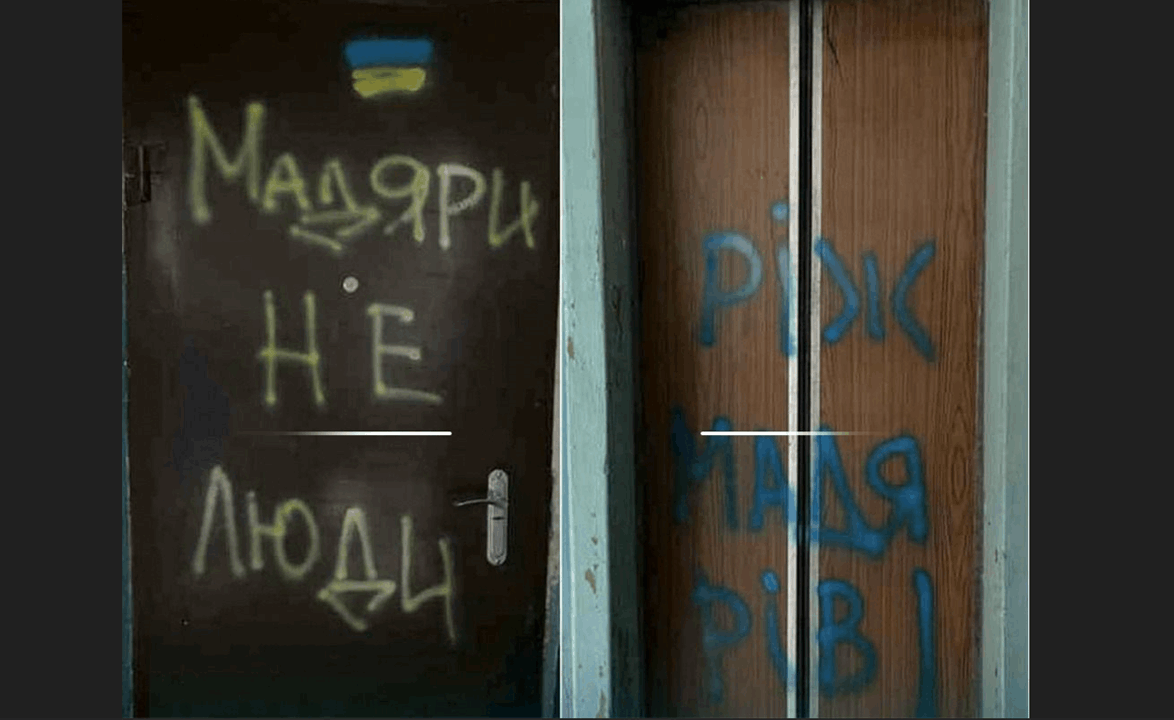Anti-Hungarian graffiti urges Ukrainians to kill all Hungarians in Transcarpathia, Ukraine’s westernmost county

Unknown individuals have spray-painted anti-Hungarian graffiti on the door and wall of a building in Mukachevo (Munkács). One message called for Hungarians to be slaughtered, while another declared that Hungarians are not human. Approximately 80,000 Hungarians currently live in Transcarpathia, although many—especially men—have fled in recent years. Ethnic tension had not previously been a major issue, despite the ongoing resettlement of refugees from Eastern Ukraine.
The end of ethnic harmony in Transcarpathia?
For those who imagine Transcarpathia as a predominantly Hungarian region in Ukraine’s westernmost corner, the reality may be disappointing. Even before the Treaty of Trianon (1920), Hungarians never constituted a majority in this area, which once belonged to the Kingdom of Hungary. Today, ethnic Hungarians make up just over 10% of the population and form a majority only in a narrow strip along the border.
This makes maintaining ethnic harmony all the more critical, as Hungarians remain a small minority even within the region. Meanwhile, the influx of refugees from Eastern Ukraine and the mass emigration of tens of thousands of Hungarians in recent years continue to reshape the demographic landscape.

Harsh criticism from Hungary amid Ukraine’s fight for survival
As Ukraine battles for its very survival against Russia’s invasion, the Hungarian government has repeatedly criticised President Zelensky, accusing him of deliberately prolonging the war and refusing to make peace with Russia. Hungarian officials claim Kyiv aims to drag the EU and NATO into the conflict. So far, this diplomatic feud has not significantly impacted Transcarpathia—but recent incidents suggest that may be changing, or at least that some actors are attempting to change it.
A recent attempt to set fire to the sacristy door of the Greek Catholic Church in Palágykomoróc was accompanied by graffiti calling for the extermination of Hungarians. Hungary’s government condemned the act, blaming Ukrainian extremists, and Prime Minister Viktor Orbán denounced it in a strongly worded social media post. However, geopolitical expert András Rácz speculated that Budapest may have known about the attack in advance and suggested it could have been a false flag operation.
- Anti-Hungarian slogans and church vandalism in Transcarpathia: a false flag the Hungarian government knew about?
Clumsy attacks and provocations
This is not the first incident of its kind. In 2018, the headquarters of the Hungarian Cultural Alliance (KMKSZ – Cultural Association of Hungarians in Transcarpathia) was set on fire. Investigations later revealed that the attack had been ordered by Russians and carried out by Polish mercenaries in an effort by Putin’s regime to destabilise the region.
That does not rule out the possibility that the current graffiti was spray-painted by Ukrainian extremists. Ukrainian authorities swiftly arrested a 28-year-old suspect in the Palágykomoróc case. However, the perpetrator’s lack of local knowledge became evident when it emerged that the defaced church is not even used by local Hungarians, who are predominantly Calvinist.
- Ukraine allegedly catches Hungarian spies monitoring public opinion on potential march-in
“Slaughter the Hungarians”
Among the latest anti-Hungarian graffiti are messages personally insulting both Hungarians and Prime Minister Orbán. Hungarian MP Máté Kocsis shared two of the messages: “Hungarians are not human” and “Slaughter the Hungarians.” The news outlet Szeretlek Magyarország received photos including an additional obscene message targeting Orbán. The article includes large-format images of the offensive graffiti.

According to Kocsis, the Hungarian government condemns all anti-Hungarian actions and stands firmly in support of the Hungarian community in Transcarpathia.
There is hope that the situation will not escalate further, as the survival of the local Hungarian minority is already hanging by a thread.
More from our Transcarpathia archive.
To read or share this article in Hungarian, click here: Helló Magyar







